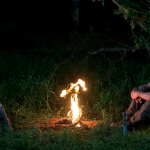Flannery O’Connor, patron saint of all things Weird and Southern, wrote, “The image of the South, in all its complexity, is so powerful in us that it is a force which has to be encountered and engaged. The writer must wrestle with it, like Jacob with the angel, until he has extracted a blessing.” Several of us here at Christ and Pop Culture are Southerners of one stripe or another, and I, for one, find it refreshing to see how non-Southerners react to the various mixes of the holy and the profane that we have down here. When, a few weeks ago, my Northeastern friend Steve Bertolino wrote about an obscure semi-documentary film called Searching for the Wrong-Eyed Jesus, he inspired me to put it on my Netflix queue immediately. Here we offer Steve’s original post from his blog Sounding Plumbline, in hopes that other readers may be similarly inspired. – Carissa Smith
The title Searching for the Wrong-Eyed Jesus is taken from an album by a singer-songwriter named Jim White, who is middle-aged, has worked about as many jobs as how old he is, and whose personality seems to be directly from the pages of a William Faulkner story. White is also the Virgil for our journey (the director being British and having no idea how to get around the Deep South). White secures a rental car for us from 1970, promising it will help encourage locals to speak with us. Then he buys a life-size Jesus made of concrete, with closed eyes, hands pointing to a Sacred Heart on His chest, for 65 dollars. The statue is too big for the trunk, but with the aid of some rope, rides comfortably for the rest of our journey with His head and shoulders poking out the back. And that’s how it all begins.
We get White’s thoughts on the South as we drive around, the camera alternating between looking at him and looking out the window at tin houses, swamps, truck stops and tangled forests of what look like the most anemic trees in existence. There’s mountain cabins, coal mines, churches, churches that look like truck stops, and the “Jesus Is Lord Cafe, Catfish Restaurant and Truck Stop.” White’s comment upon driving up: “Now this place…it’s so wrong, it’s right.” (Believe it or not, I found the most moving part of the film to take place there.) Pentecostal tradition, if not always actual Pentecostalism itself, seems to be in the forefront of the Southern life. In one of his more lucid comments, White says that “Gravity is stronger here, in the South. It pulls on you more.” Later on someone says, “Growing up here, Saturday night would come, and that’s where you made your choice, to be a sinner and go to the bars, or be saved and go to church the next morning.” White grew up in the South, left as a teenager and lived in other parts of the country and abroad, and then chose to go back, “trying to find the gold tooth in God’s crooked smile.”
As we meander through one-street towns, state prisons, seedy bars (White refuses to go in one of them, saying it “would be educational for you, but I already know what they have to offer”), barbershops, trailer parks, revival tents, and swamp cabins, we hear other people’s stories, and hear them telling stories they’ve heard. Killings, maimings, and religion seem to be the standard fodder, with cruel justice, revenge, and mental breakdowns their usual end. Harry Crews, a Southern writer I hadn’t heard of before but am now curious about, pops up in a few places, quoting Goethe and talking about how his mother told him to bury possums he’d shoot as a kid. There’s the requisite scene of a congregation being stirred up by a shouting, sweaty preacher into “being slain in the Spirit” and speaking in tongues. More striking for me was a wrinkled old woman in a purple blazer, speaking over the radio, her cheeks sagging, inviting people to be saved. She’s physically more ethereal and ghostly than the distant, angry God she talks about, and one look in her eyes tells you she’s half-crazy, like Suzanne in the Leonard Cohen song, and believes every word she’s saying. We watch her preach over the airwaves for minutes that seem like hours.
And then there’s the music. The documentary is saturated with music, most all of it old-timey, with banjos and chipped electric guitars. This is an O Brother, Where Art Thou soundtrack without the hope of songs like “Big Rock Candy Mountain” or “Angel Band”, talking more of the same death and destruction, loneliness and violence, that populates the stories being told. Numerous artists appear and play parts of songs with titles like “Crossbones Style”, “The Last Kind Words”, “The Wound That Never Heals”, and the spare, chilling “Wayfaring Stranger”, first printed in a song-book in 1816 with no attributed author.
Being a Catholic kid born and raised in the Northeast, mentored predominantly by Protestants in college and grad school, and remaining Catholic while committed to ecumenical ministry, I found the fiery heat and sour tang of Pentecostalism portrayed in the film to be oppressive, ludicrous, and charged with meaning all at the same time, which is probably why I was thinking of Flannery O’Connor the whole way through. White also seems to have the old girl on his mind, and references her concept of “the wise blood” at the end of the film, as a voiceover during a nighttime baptism in some muddy river, the scene illuminated only by headlights of cars. It seems a fitting second-to-last image for the movie (we still have the concrete Jesus to deal with, of course), because the scenery surrounding the river may be beautiful, but probably not, and anyway it’s dark outside. A small gathering of people wait in the sharp headlamps, the camera lingering over their weird shadows. The preacher pushes the woman under the cold water, and she goes limp as he and another man pull her up and drag her by her arms back towards the bank. Is she “slain”? in shock? overcome by emotion? even conscious? There’s something powerful about the idea that a conversion experience destroys a person; Christianity does talk about the death of our earthly, sinful nature when we are baptized. Watching this documentary, I feel a creeping suspicion that, if a baptism could ever bring about a literal death, it would happen in the Deep South, somewhere in that maze of dirt, swamp, bayou, scrub, and blood.











